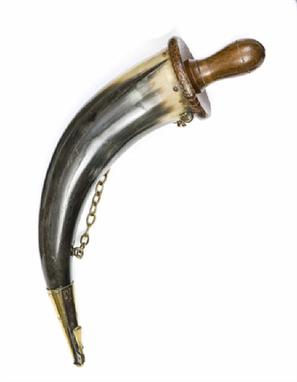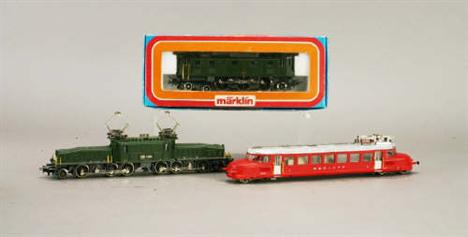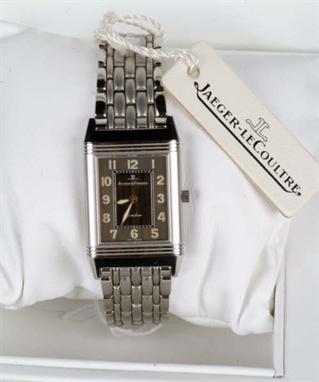We found 32198 price guide item(s) matching your search
There are 32198 lots that match your search criteria. Subscribe now to get instant access to the full price guide service.
Click here to subscribe- List
- Grid
-
32198 item(s)/page
A scarce .577/450" Martini Henry Cavalry carbine, 37½" overall, barrel 21¼" with military proof and inspector's marks at breech; the frame engraved with crowned VR over "Enfield 1877 I.C.1" and stamped with broad arrow over "SA/291", pale walnut fullstock, the butt with "RM Enfield" store keeper's mark and Government sale mark; original steel cleaning rod. GWO & C Plate 12
A CHARLES I PEWTER BROAD-RIM CHARGER engraved with the arms of the Swain family of Tarrant Gunville and their crest of a demi-dragon supporting an arrow, the reverse with the touch of Nicholas Dolbeare (circa 1620 -51), 221/2" dia. (576mm) with a 91mm semi-broad rim. Provenance: The Swayne family at Tarrant Gunville, Dorset until 1715 when Abigail Swayne married William and Elizabeth Harbin's second son, Wyndham. It is as a result of this marriage that this charger came to be at Newton Surmaville. Nicholas Dolbeare is renowned for supplying pewter to the Edgcumbe family of Cotehele, Cornwall. The "garnish" of pewter chargers (Lots 640-644) has been at Newton Surmaville for well over 300 years but they started life in another local house, Trent, three miles north east of Yeovil. They bear the arms of Sir Francis Wyndham and his wife Anne. After the death of Anne's father, Thomas Gerard of Trent, whose Estates were divided in 1651 between his five daughters, Trent went to Anne and her husband Sir Francis Wyndham and became their main home. The chargers must, therefore, date somewhere between 1646, when Francis and Anne were married, and 1672 when Thomas Haward, the maker, died. It does not seem unreasonable to assume that the garnish was made during the reign of Charles I to celebrate the marriage of Sir Francis Wyndham Bt. and Anne Gerard of Trent in 1646. Francis and Anne's third daughter, Elizabeth, married William Harbin of Newton Surmaville and it must be through that marriage, in 1673, that the garnish found its' way to Newton Surmaville where it has remained to this day. The Wyndhams were a prominent Royalist family and Sir Francis and Anne gave Charles II refuge at Trent after the battle of Worcester before he fled to the Continent. By the time of his death in 1676, Sir Francis had also acquired Pilsdon Hall in Dorset from his uncle. His short will is concerned with his estates and major bequests and does not descend into detail, but in a reference to his third daughter is a codicil to the will giving "my daughter Harbin £30 to buy her a ring or other jewel that she shall best like". His goods and chattels were all left to his wife. The probate inventory of those goods and chattels is much lengthier than his will. Indeed, it takes up ten feet of parchment as it goes through the contents of 22 rooms at Trent and then another 22 at Pilsdon. It seems reasonable to assume that the following garnish was at Trent. The inventory refers to "nine great pewter dishes and nine dozen of old plates, six dozen of newe plates …". The valuation of the pewter at Trent was given as £20 5shillings. According to the Journal of the Pewter Society (Spring 2008) the Newton Surmaville garnish is "an extraordinary set of chargers with no known parallels elsewhere". Each charger has on the front rim the hallmarks of Thomas Haward of London and his touch on the reverse. Haward was made free in February 1636/7 and he set up shop a year later. He died towards the end of 1672. Only one other exceptionally large charger by him has been recorded, a 26.75" example with a multi-beaded rim from the Shemmell Collection. That rim style only came into fashion at the end of Haward's working life. The broad rim style of the present garnish, in contrast, could have been made at any time during his working life.
Macdonald, Philip. The link, [1930], dust-jacket; [Ibid.]The noose. 1930, facsimile dust-jacket; [Ibid.] The crime conductor. 1932, facsimile jacket; [Ibid.]The choice. 1931; [Ibid.]The rasp. 1924, presentation copy inscribed by the author, facsimile jacket; [Ibid.]The crime conductor. 1931. First American edition; these all first editions except where stated; and six others; Mason, A.E.W. The house in Lordship Lane. 1946, dust-jacket; [Ibid] The house of the arrow. [1924], facsimile jacket; [Ibid.]The prisoner in the Opal. [1928], facsimile jacket; [Ibid.]At the Villa Rose. 1910, facsimile jacket; [Ibid.] The wouldn't be chessmen. 1935, dust-jacket; first editions, and five others; original cloth bindings; 8vo (22) .
British School (mid-late 1960s), a welded iron sculpture, for wall mounting, welded signature device of an arrow, 92cm high, 280cm wide, 32cm deep. Commissioned for Broadwalk House, Hyde Park Gate, London in 1968 (Chapman,Taylor and Partners, architects). Visit www.dnfa.com for condition reports.
A black plastic Stephens Lever Fill No. 270 fountain pen, with an arrow shaped pocket clip, a gilt metal Cross propelling pencil, cased, a gilt metal Cross fibretip pen set, cased, five further writing implements, a base metal seal, a long cigarette holder with Oriental decoration, two brass travelling periscopes and more further items.
A Rolex gold square cased lady's wristwatch, the signed rectangular silvered dial with gilt Arabic and arrow shaped numerals, the strap lugs pierced with foliate motifs, on a black strap, together with a gold cased lady's wristwatch, the circular silvered dial with black Arabic numerals, with a strap.
A mid 20th Century Chrome plated Nickel open face keyless Military Pocket Watch, Leonidas, the frosted gilt and jewelled movement with mono-metallic balance, to a signed and black painted dial with luminous Arabic numerals, outside minute track, sunk subsidiary seconds and luminous filled Silver hands, in a polished case with snap-on back, marked with a government broad arrow over GSTP over T1664, width 2"
A .65" Indian Service 2 band Enfield percussion musket, 48½" overall, barrel 33" with block rearsight and Tower proofs, the plain lock stamped "Enfield", fullstocked, the butt with crowned broad arrow, "WO" and "Tower London 1860" storekeeper's mark, regulation brass mounts, sling swivels and steel ramrod. GWO & Basically GC (small repair to butt, worn overall)
A pink lustre decorated pearlware jug, early 19th Century, printed and enamelled with the verse 'Art thou not dear unto my Heart ...' beneath a heart pierced with an arrow and a loving couple standing beside, to the reverse the verse 'This is a good world that we live in ...' beneath a family in a landscape setting, the neck with a band of flowers beneath the pink lustre scalloped edge, height approx 14.5cm.
Girard-Perregaux for Ferrari, 250GT TdF Limited Edition No 1613, a gentleman's stainless steel wristwatch, the two piece screw down case push buttons and arched lugs, the black dial with luminous Arabic numerals, luminous arrow hands, centre seconds hand and minute indicator, three subsidiary dials running seconds, minutes and 24 hours, 46 jewel Girard-Perregaux automatic movement cal: ZZ80U781, on a Girard Perregaux strap with steel buckle, case 3.9cm diameter, with a veneered Girard-Perregaux box, paper work and outer card packaging.
Tudor, Oyster-Date Ranger, a gentleman's stainless steel wristwatch, circa 1951, ref: 7966/0, No 589415, the two piece screw down case with polished bezel and screw down crown, the black dial with luminous Arabic numerals and baton markers, luminous arrow hands, centre seconds hand and magnified date aperture, 27 jewel Tudor Auto Prince automatic movement cal: 2484, on a brushed stainless steel Oyster bracelet with Rolex fold over clasp, case 4.2cm long including lugs.
Chopard, Imperiale Chronograph, a gentleman's stainless steel wristwatch, circa 1995, ref: 8219, No 389790, the two piece screw down case with cylindrical lugs set with cabochon sapphire terminals, the two chronograph pushers and winding crown also set with cabochon sapphires, the silvered dial with raised Roman numerals, arrow hands, centre seconds hand, three subsidiary dials running seconds, minutes and hours and date aperture, 54 jewel Chopard automatic movement adjusted to four positions cal: 889/2 No 266463, on a black Chopard strap with a Chopard stainless steel buckle, case 4.5cm long including lugs, with the original guarantee booklet and certificate of origin.
Jaeger-LeCoultre, Reverso, a gentleman's stainless steel wristwatch, ref: 251.8.86, No 1831963, the three piece reversible case with black dial, Arabic numerals and arrow hands, 18 jewel Jaeger-LeCoultre movement adjusted to four positions cal: 645/1, on an integral polished and textured brick link bracelet with Jaeger-LeCoultre snap clasp, case 3.3cm long, in a Jaeger-LeCoultre box with the original guarantee and paper work.
Omega, Speedmaster Broad Arrow Chronometer, a gentleman's stainless steel wristwatch, ref: 178-0022, No 78004183, the two piece screw down case with screw down crown, push buttons and tachymetre bezel, the black dial with baton numerals, luminous arrow hands, date aperture at the 6 o'clock position, centre seconds hand and three subsidiary dials running seconds, minutes and hours, 33 jewel Omega automatic movement adjusted to five positions cal: 3303, on an integral stainless steel block link bracelet with Omega fold snap clasp, case 5cm long including lugs, with an Omega box.
Omega, Seamaster Planet Ocean, Professional Co-axial Chronometer, a diver's stainless steel wristwatch, ref: IAF 168 1650 29005037, No 80974925, the two piece screw down case with black rotating bezel calibrated for 60 units, screw down crown and helium escape valve at the 10 o'clock position, the black dial with luminous Arabic and baton numerals, luminous arrow hands, centre seconds hand and date aperture, 27 jewel Omega Co-axial movement cal: 2500 No 80974925 adjusted to five positions and temperature, on a tan strap with an Omega stainless steel deployant clasp, case 5.1cm long including lugs, with a fitted Omega box and guarantee card.
Cartier, Pasha, gentleman's stainless steel wristwatch, circa 2001, ref: 2378, No 64251CD, the two piece screw down case with crystal display back, screw down lugs, rotating bezel calibrated for 60 units and cabochon synthetic sapphire screw down winding crown guard, the silvered engine turned dial with Arabic numerals, luminous arrow hands and off set date aperture, 27 jewel Cartier movement cal: 191, on an integral block link bracelet with concealed Cartier snap clasp, case 4cm diameter, with a fitted Cartier box with the original guarantee and paper work and outer card packaging.
Cartier, Pasha Grille, a gentleman's stainless steel wristwatch, circa 2001, ref: 2379, No 90044C.D, the two piece screw down case with crystal display back, rotating bezel calibrated for 60 seconds, cabochon synthetic sapphire screw down crown guard and screw down lugs, the glass with a grill cover, the engine turned silvered dial with Arabic numerals, luminous arrow hands and off set date aperture, 27 jewel Cartier automatic movement cal: 191 No 99214, on a conforming brick link bracelet with Cartier concealed snap clasp, case 3.9cm diameter, in a Cartier fitted box with the original guarantee and paper work and outer card packaging.
Cartier, Pasha, a gentleman's stainless steel wristwatch, ref: 1033, No CC281729, the two piece screw down case with rotating gold bezel calibrated for 60 seconds, cabochon synthetic sapphire set screw down winding crown guard and screw lugs, the cream dial with Arabic and baton numerals, luminous arrow hands, magnified date aperture and power reserve indicator, 20 jewel Cartier automatic movement cal: Z892AZ ref: Cartier 050, on a tan strap with an additional stainless steel Cartier deployant clasp, case 3.7cm diameter, with a red leather bound Cartier Pasha box, paper work and outer card box.
A RARE FRENCH STEEL HELMET FOR THE EGYPTIAN KHEDIVE'S BODYGUARD, SECOND HALF OF THE 19TH CENTURY, with one-piece skull, fitted with a steel crescent on a conical scalloped brass washer in the centre, moulded brass band around the base, sliding nasal formed as an arrow, and neck-guard with brass rim (worn, throughout, the skull with a small hole, chin scales missing), 28cm 11in high, A more elaborate example is preserved in the Stibbert Museum Florence, inv. no. 16636. See L. G. Boccia 1975, pp. 216-7, no. 783.
A Third Reich Officer's Peak Visor Cap in green wool mix with purple piping, black cap-band, alloy national eagle and death's head insignia, silk lining with cellulloid diamond, of later manufacture; a Foreign Legion (Other Ranks) Kepi, with regulation red grenade device, the liner marked 'Pierre Huard & Cie, Paris, size 58'; a Khaki Drill Flying Helmet, the felt lining marked WD with ministry arrow device; six assorted Berets, including a standard khaki version, the lining stamped Jalpotex, Ltd. 1945, (9).
A British Military Issue Gurkha Kukri Knife, the blade with various markings 10 3 & DH IG, 1918, 8, regulation walnut grips, in its brown leather covered wooden sheath, stamped 1940, with ministry arrow device; a Great War US Remington P17 Bayonet, single edged blade 17in.(43cm) long, grooved walnut grips, lacking scabbard; a Brass Hilted Briquet Sidearm, curved blade, single knuckle-bow, ribbed grip, in its brass mounted leather scabbard, with damage, (3).
A 19th Century Russian Percussion Cap Three Band Musket, the 108cm steel barrel indistinctly numbered, the muzzle band missing, with back action, walnut full stock, the brass bands, trigger guard strap and butt plate stamped with a bow and arrow over 1847, the butt plate stamped with the Russian double headed eagle, with leather sling.
An 18th century carved oak coffer the planked lid with moulded edge and the original iron strap hinges, above a panelled front & sides, the front panels carved with foliated lozenge and sunburst decoration, surrounded by frieze panels with scroll and arrow carving, standing on stile supports, 51in. (130cm.) wide x 24.75in. (63cm.) high.
-
32198 item(s)/page








![Macdonald, Philip. The link, [1930], dust-jacket; [Ibid.]The noose. 1930, facsimile dust-jacket; [Ibid.] The crime conductor](http://lot-images.atgmedia.com/SR/10121/2765992/296-12810120-10121_468x382.jpg)



































